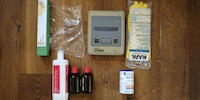
Guide
This is how "simply" you can de-yellow your old console
by Philipp Rüegg
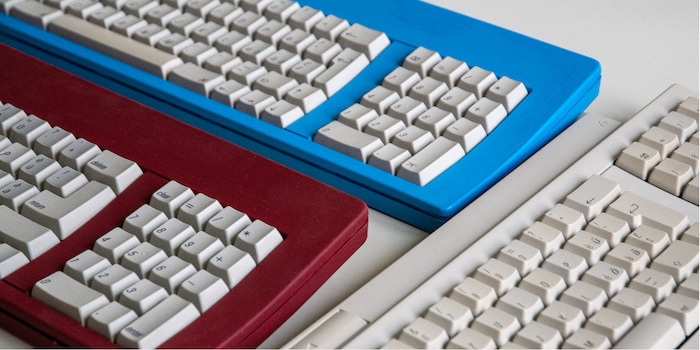
I recently refreshed three antique Apple keyboards and tested their suitability for everyday use. During the process, I gained a lot of useless knowledge about old switches, degilding methods, and abstruse keyboard layouts. Not that productive, but quite a lot of fun.
Mechanical keyboards are the gold standard when it comes to typing feel. Recently, I too have been infected by my colleagues’ enthusiasm. I don’t think I’ll ever go back to rubber keyboards. However, my Logitech G915 isn’t as durable as most usual mechanical keyboards. The keycaps are very fragile, and Logitech doesn’t provide replacement parts. Common practice among proprietary systems.
But on the topic of longevity, I suddenly remembered owning three Apple keyboards that were all over 30 years old. Didn’t all keyboards used to be mechanical? And wouldn’t it be incredibly cool to bring an 80s keyboard to life with a new computer? It tried this out, using an ADB2USB adapter made by the small Drakware company, with which I already tested an old mouse.
All three keyboards are leftovers from old Macintosh computers. I used such old Macs in my childhood and youth, before later buying them again on Ricardo.ch for nostalgic reasons. First, I connected my preferred keyboard: an «Apple Standard Keyboard» from 1987. I painted it blue many years ago, as it tended towards a rather ugly yellow with prolonged use. At the time, I still had no idea what chemicals would remove any discolouring.
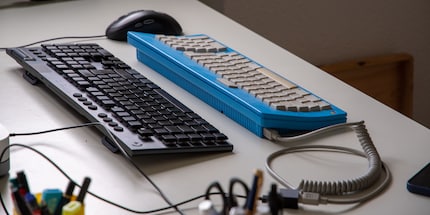
The keyboard is quite heavy. It’s loud too. There are no feet to adjust the angle of inclination. Or function keys. And the arrow keys require some getting used to.
But this all isn’t as bad as it first seems. Since the vast majority of Mac keyboards didn’t have function keys in the past, there are still no F-key commands firmly anchored into the system. In other words: you definitely don’t need them to work on a modern Mac. The missing Del key can be simulated on a Mac by combining Shift + Delete. I got used to the arrow key layout quite quickly, and besides, the number pad can also be used for arrow navigation. Option + Clear corresponds to the Num Lock on a Windows keyboard.
Using this keyboard to write is truly stimulating. It’s true, typing isn’t as easy as on my modern Logitech keyboard. But at least I get the feeling of working on a device that was built to last. The keyboard has a loud but pleasant sound. Unfortunately, I mistype quite often when using it. I can’t pin down a reason why.
At this point, I had to make a decision: is this thing good enough for me to use on a daily basis, or should I go back to my Logitech keyboard? But instead of looking for an answer, I tried to improve the old keyboards. Needless to say, things escalated.
The newest of the three keyboards – a 1990 Apple Keyboard II – looks more modern, and I suspected it would also be more comfortable to type on. However: in this state, I wouldn’t even touch the thing. Dissection and cleaning are required.
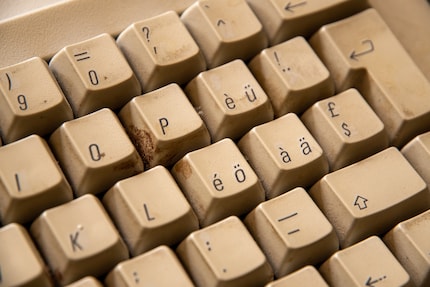
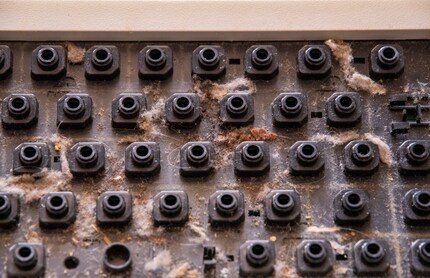
In doing so, I quickly noted: this isn’t even a mechanical keyboard! Or at least not really. Each key has its own switch, but instead of a metal spring, a kind of rubber spring is used. Thus, it seems to be a hybrid mechanical and rubber membrane keyboard.
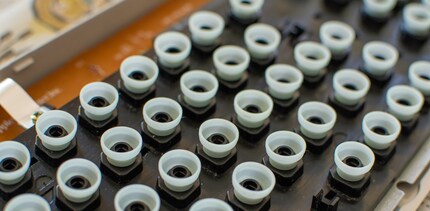
Are the two older models «true» mechanical keyboards, at least? And this weird mix, is it good or bad? Since I approached the matter cautiously, I first checked out at a few YouTube videos on the subject and quickly realised: mechanical keyboards are a science, a universe unto themselves.
At some point I discovered Chyrosran22, a user who has reviewed over 160 old keyboards. He swiftly answered all my questions. The Apple Standard Keyboard is a classic mechanical keyboard with switches made by the Alps brand. The Apple Keyboard II is a good example of the fact that it is often impossible to tell what is mechanical and what is not. There are so many different ways keyboards can be constructed that any definition of «mechanical» will somehow always end up unsatisfactory. Ultimately, the expression describes more of a subjective typing sensation than actual interior structures – the keyboard shouldn’t feel rubbery.
But no matter which definition you use: Both of my standard Apple keyboards are mechanical. And both switches are considered to be quite high-quality. Maybe the typing feel will get even better if I clean them? It would definitely help aesthetically – the keys are visibly dirty. I decided to refresh these keyboards as well.
Key caps for the Apple Standard Keyboard are made of PBT plastic. A material which does not yellow. But the space bar uses ABS plastic, and this material does yellow over time. Thus, the space bar has a slightly different shade, which is quite unattractive. The housing is also made of ABS, but I painted it over anyway. One of my standard keyboards is blue, the other orange. In this picture, you can clearly see that the space bar is yellowed, unlike all the other keys.
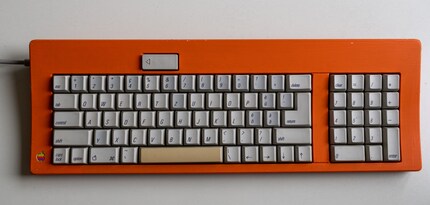
All external components in the Apple Keyboard II are made of ABS and yellow accordingly.
In a fit of madness, I decide to de-stain all the ABS keys as well as the case for my Apple Keyboard II with hydrogen peroxide and repaint them both. The colour was a little off here and there, and I don’t enjoy the orange any more anyway. These days, I’m more into burgundy.
Now, de-yellowing is again a science in itself. But not an exact one. More akin to something like alchemy. Using the keyword retrobright, a diverse range of mixtures and methods are offered for sale online. My colleague Philipp Rüegg tested his might on an old Nintendo console once – it worked out, but at a huge effort (article in German).
I didn’t make things unnecessarily complicated for myself, ordering properly concentrated hydrogen peroxide from an online retailer I trust, into which I placed the detached keycaps. On a sunny day in late May, they can absorb quite a bit of UV light from my south-facing balcony. I spared myself any further detergents, bleach or tools from the food industry.
The case itself was too large to be inserted. So I just brushed the hydrogen peroxide on it, repeating the process a few times. This also worked out surprisingly well. All cases and keys now had about the same colour. The yellow tint wasn’t completely gone, but compared to the original state of the keyboard, this was definitely an improvement.
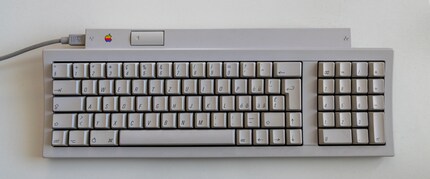
The painting process was more of a challenge. I had to apply several coats of paint. The thick paint stiffened the keyboard, making it difficult to put together. Also, be sure to put the space bar on before assembling, as you won’t be able to attach it later on. But as my space bar had to be cleaned itself, I messed up in just this way. Welp, time to start all over again.
Apple Keyboard II: the rubber switches do feel rubbery when used. I don’t get the sensation that this is a mechanical keyboard. The keyboard would actually be pretty quiet, if it weren’t for the clattering space bar. Needless to say, I will certainly not be using this keyboard.
Blue Apple Standard Keyboard: this model uses Alps SKCM Orange switches. These have quite the reputation, yet typing still doesn’t come easily on this keyboard. This didn’t change, even after cleaning. The 6 on the numeric keypad wouldn’t work at first, but after some jiggling and pushing around, it regained consciousness.
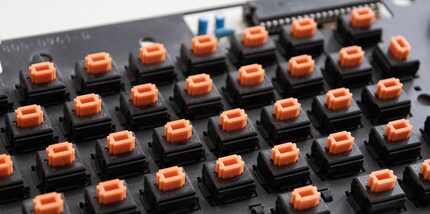
The formerly orange, now red Apple Standard Keyboard: three keys wouldn’t work here at first, but everything settled down after a while. The red keyboard does differ from the blue one in several ways. For example, the switches: here, Alps SKCM Salmon comes into play. Coloured in, you guessed it, salmon. They didn’t seem to different from the orange ones. I prefer typing with this keyboard a bit more than with the blue one.
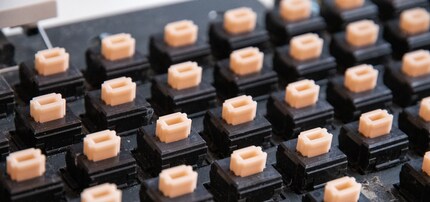
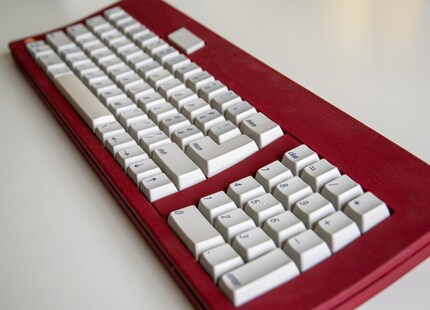
Unfortunately, the red keyboard also has some disadvantages when compared to the blue model. Most obviously, it’s a US device onto which the correct Swiss key designations were later pasted. Amazingly, these adhesives held up decades later, even after being cleaned. However, some special keys were forgotten, and are now incorrectly labelled for Swiss users. But even for red-blooded Americans, this keyboard takes a lot of getting used to, as many keys are, to put it nicely, arranged in an original way. The arrow keys are all in a row, Caps Lock and Ctrl are swapped, and next to the space bar, instead of a second command or Alt key, you’ll find some special characters for which there was no room anywhere else. The shift keys are extremely large, the space bar extremely small. At least the Esc key is in its usual place, not next to the arrow keys like on the Apple Keyboard II.
Drakware does offer a tool to reprogramme keys. Maybe I can find a keyboard layout that makes sense for me. But honestly: for daily use, none of the three keyboards are comfortable enough for me. I will continue to use them for what they are: nostalgic memories of days long past. Was all my work for nothing? No – I enjoy a good vintage.
My interest in IT and writing landed me in tech journalism early on (2000). I want to know how we can use technology without being used. Outside of the office, I’m a keen musician who makes up for lacking talent with excessive enthusiasm.
Interesting facts about products, behind-the-scenes looks at manufacturers and deep-dives on interesting people.
Show all